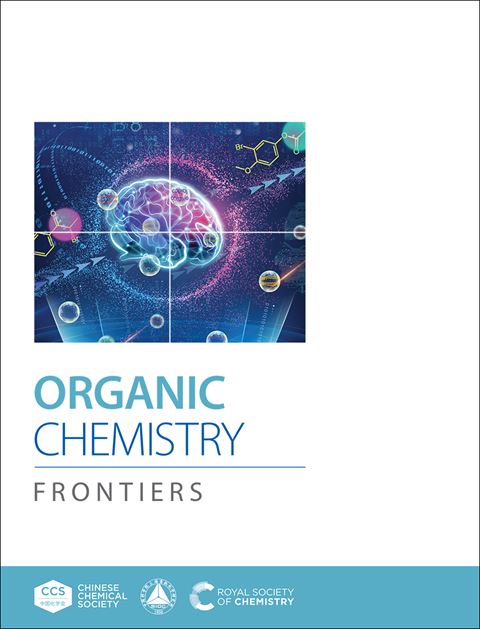Ligand-centered redox driven Zn(II)-catalyzed anti-markovnikov hydroamination of activated alkenes with primary aromatic amines via aminium radical cations
IF 4.7
1区 化学
Q1 CHEMISTRY, ORGANIC
引用次数: 0
Abstract
A ligand-centered redox-driven strategy for anti-Markovnikov hydroamination of electron-deficient alkenes including acrylates, acrylonitrile, and acrylamides-enabled by a well-defined Zn(II)-catalyst bearing a redox-active arylazo-phenanthroline ligand is reported.The azo-functionalized ligand serves as the key redox mediator, enabling single-electron transfer (SET) from primary aromatic amines to the low-lying π*-acceptor orbital of the ligand scaffold, generating aminium radical cation intermediates that engage in regioselective radical hydroamination under thermal conditions (100 ºC), circumventing the need for precious metals, external oxidants, or photochemical activation. The protocol demonstrates broad substrate scope and functional group tolerance, efficiently transforming a variety of amines, including heteroaryl, electron-rich, and complex amines derived from natural products, into valuable hydroaminated products. Mechanistic studies support a radical pathway initiated by SET to the azo-functionalized catalyst, with the redox-active ligand mediating all key electron-transfer events while the Zn(II)-center acts as a coordination scaffold. This work highlights the potential of redox-active ligand systems to enable sustainable radical pathways for C-N bond formation, introducing a new catalytic paradigm for the selective hydroamination of electron-deficient alkenes to access linear alkylamine frameworks.配体中心氧化还原驱动Zn(II)通过胺自由基催化活化烯烃与伯芳胺的反马尔可夫尼科夫氢胺化反应
本文报道了一种以配体为中心的氧化还原驱动策略,用于抗缺电子烯烃(包括丙烯酸酯、丙烯腈和丙烯酰胺)的马尔可夫尼科夫氢胺化反应,该策略由具有氧化还原活性的芳基偶氮-菲罗啉配体的明确定义的Zn(II)催化剂实现。偶氮功能化的配体作为关键的氧化还原介质,实现了从初级芳香胺到配体支架的低位置π*受体轨道的单电子转移(SET),产生胺自由基阳离子中间体,在热条件下(100ºC)参与区域选择性自由基氢胺化,绕过了对贵金属、外部氧化剂或光化学激活的需要。该方案显示出广泛的底物范围和官能团耐受性,有效地将各种胺,包括杂芳基胺,富电子胺和天然产物衍生的复合胺,转化为有价值的氢胺化产物。机制研究支持由SET引发的自由基途径到偶氮功能化催化剂,氧化还原活性配体介导所有关键的电子转移事件,而Zn(II)中心充当配位支架。这项工作强调了氧化还原活性配体系统的潜力,为C-N键的形成提供了可持续的自由基途径,为缺电子烯烃的选择性氢胺化获得线性烷基胺框架引入了一种新的催化范例。
本文章由计算机程序翻译,如有差异,请以英文原文为准。
求助全文
约1分钟内获得全文
求助全文
来源期刊

Organic Chemistry Frontiers
CHEMISTRY, ORGANIC-
CiteScore
7.90
自引率
11.10%
发文量
686
审稿时长
1 months
期刊介绍:
Organic Chemistry Frontiers is an esteemed journal that publishes high-quality research across the field of organic chemistry. It places a significant emphasis on studies that contribute substantially to the field by introducing new or significantly improved protocols and methodologies. The journal covers a wide array of topics which include, but are not limited to, organic synthesis, the development of synthetic methodologies, catalysis, natural products, functional organic materials, supramolecular and macromolecular chemistry, as well as physical and computational organic chemistry.
 求助内容:
求助内容: 应助结果提醒方式:
应助结果提醒方式:


